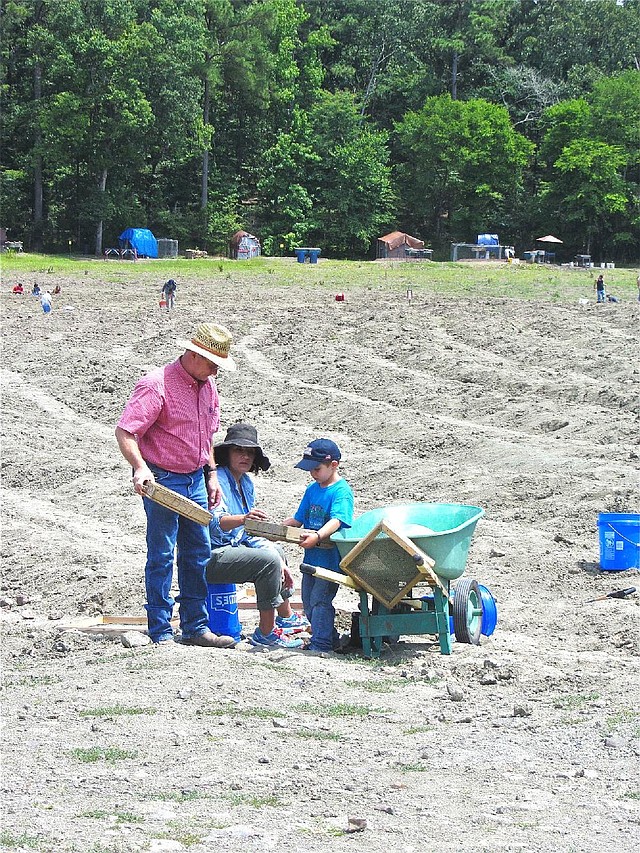Where dusty diggers dream of a dazzling find
A family digs together in the 37-acre gem field at Crater of Diamonds State Park, two miles southeast of Murfreesboro.
Thursday, July 10, 2014
MURFREESBORO -- Hitting pay dirt is a long shot. That's true whether you're looking for the love of your life, buying a Powerball ticket or digging at the only diamond mine in the world that lets visitors keep any precious gems they unearth.
On a recent sunny but not unbearably hot afternoon, the numbers posted at Crater of Diamonds State Park gave an idea of the long odds: no unearthed diamonds registered so far; three of them the day before; 277 so far this year; 455 last year.
That's only a diamond or two per day, almost all of them a tiny fraction of a carat in weight (a 1-carat diamond being about the size of a green pea). The typical find here makes a distinctive souvenir but it isn't a fast track to wealth.
The very slight chances of a bonanza seemed to matter little to dozens and dozens of grown-ups and youngsters (including one young man in a wheelchair). They were merrily digging away and sifting the dirt they'd dug from the 37 acres of furrowed soil. A few had brought beach umbrellas to shelter from the sun.
These day-tripping prospectors had more modest goals: having some family fun; being able to boast about a novel adventure; then perhaps cooling off with a splash in the site's thronged Diamond Springs Water Park.
Crater of Diamonds' visitor center offers searching enticement with exhibits focusing on the really rare spectacular finds. On prime display: the Strawn-Wagner Diamond, which Murfreesboro resident Shirley Strawn turned up in 1990.
This dazzler is celebrated not for size (originally 3.03 carats) but for quality. An unprecedented Triple Zero grade makes it the closest to perfect of any diamond ever certified by the American Gem Society -- said to be a one-in-a-billion specimen. Cut in 1997 into a 1.09-carat finished diamond, it was sold to Crater of Diamonds for $36,000.
A brochure lists the 19 diamonds of 6 carats or more known to have been found here since the first discovery in 1906. The largest, a 40.23-carat beauty known as the Uncle Sam, was unearthed in 1924 when the site was privately owned. Attempts over the years to mine commercially have failed and the property became a state park in 1972.
One exhibit explains that a volcanic eruption maybe 100 million years ago led to the creation of diamonds in this spot. They are the most desired of the stones here, but diggers can also find amethyst, quartz, jasper, calcite and other minerals.
Newcomers can benefit from several listed diamond-hunting tips: Look for a small, well-rounded crystal. Look for clean crystals, because diamonds have a slick outer surface that repels dirt or mud. Diamonds may be of several colors, the most common here being white, yellow and brown.
A brochure of tips cites three hunting methods: Surface searching -- closely observing the field and looking for crystals that have been exposed by rain or the monthly plowing. Screening -- shaking the soil through a screen to spot minerals too large to pass through the mesh. And wet screening -- using water available at the mine to wash dirt through a screen and see what minerals remain.
If surface searching seems a highly improbable way to find a diamond, visitors can bear in mind what happened Oct. 19, as National Geographic reported online: "As teenager Tana Clymer discovered, watching where you step can really pay off -- especially on a certain patch of volcanic soil in southwest Arkansas."
Waymon Cox, a park interpreter, recounted the amazing discovery:
"A girl from Oklahoma City and her family were out about two hours, digging and sifting with screens and buckets and shovels. They weren't having any luck, so she decided to just start 'surface searching,' looking on top of the ground. She saw what she thought was a candy wrapper, until she touched it. It turned out to be a 3.85-carat yellow diamond."
In April, the girl sold the diamond for $20,000, which she has banked to help pay for college. So maybe the dream of hitting pay dirt at Crater of Diamonds isn't so far-fetched after all.
Crater of Diamonds State Park, two miles southeast of Murfreesboro on Arkansas 301, is open for digging 8 a.m.-8 p.m. daily until Aug. 16. Starting Aug. 17, hours are 8 a.m.-5 p.m. daily, with extended 8 a.m.-8 p.m. hours Aug. 22-23 and Aug. 29-30.
Visitor center admission is free. Entrance to the diamond search area is $8, $5 for youngsters 6-12. Equipment and tools for digging are available for rent.
Diamond Springs Water Park is open noon-6 p.m. daily through Aug. 14, then Aug. 16-17, 23-24 and Aug. 30-Sept. 1.
Call (870) 285-3113 or visit craterofdiamondsstatepark.com.
Weekend on 07/10/2014
